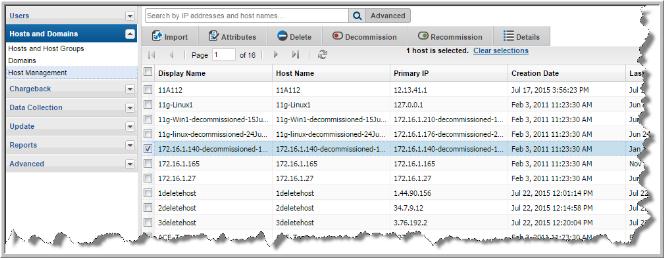Decommission/Recommission Hosts and Backup Servers
Note: Prior to APTARE StorageConsole 10, the procedure for decommissioning a backup master server directed you to change its host type to client. This previous method is no longer supported and, in fact, may result in data reporting issues. Use the procedure described in this section to decommission a host, a master server, or any other server.
Under the following circumstances, you will need to decommission a host or master server from the StorageConsole database, while still retaining its collected historical information for auditing purposes.
• Any Host: Frequently, large organizations decommission hosts and re-use the host IP addresses and/or host names. In this case, the host must be flagged in the StorageConsole database so that historical data remains, but the newly collected host with the same IP address and/or host name can be included in data collection and reporting.
• Backup Servers: When you decommission a backup master server from your enterprise, you must let the Portal know that it is no longer available for data collection. In StorageConsole, after decommissioning a backup server, the active policy clients that are no longer being backed up will not count against your backup license count.
When you decommission a host or server, StorageConsole takes the following actions, to ensure that historical data remains intact:
• Renames the host in the database, according to the following format: <host name>-decommissioned-<date>
• Logs the decommissioning actions, including the user and date, in a database audit table.
Note: Post decommissioning, when data collection encounters the re-purposed IP address or host name, a new host is created in the database.
When you recommission a host, StorageConsole takes the following actions:
• Renames the host to its original name, discarding the labels that were appended when the host was decommissioned.
• Logs the recommissioning actions, including the user and date, in a database audit table.
Note: Recommissioning a host may not be successful, as data collection may have collected another host that has been brought online with the same name or IP address.
To decommission a host or a backup server
1. Select
Admin > Hosts and Domains > Host Management.

2. Enter your search criteria to find your target set of hosts or backup servers.
3. Select the items to manage. You can select all the items on a page by clicking the checkbox on the top of the management page. Note, only all the items displayed on a single page are selected.
4. Click Decommission. Two confirmation dialogs are displayed.
5. Enter your password. This is the same password with which you logged into StorageConsole. This is an audited process.
When you decommission a host or server, StorageConsole takes the following actions, to ensure that historical data remains intact:
• Renames the host in the database, according to the following format: <host name>-decommissioned-<date>
• Logs the decommissioning actions, including the user and date, in a database audit table.
Note: When data collection encounters the re-purposed IP address or host name, a new host is created in the database.
To recommission a host or a backup server
1. Select
Admin > Hosts and Domains > Host Management.

2. Enter your search criteria to find your target set of hosts or backup servers.
3. Select the items to manage. You can select all the items on a page by clicking the checkbox on the top of the management page. Note, only all the items displayed on a single page are selected.
4. Click Recommission. Two confirmation dialogs are displayed.
5. Enter your password. This is the same password with which you logged into StorageConsole. This is an audited process. When you recommission a host, StorageConsole takes the following actions:
• Renames the host to its original name, discarding the labels that were appended when the host was decommissioned.
• Logs the recommissioning actions, including the user and date, in a database audit table.
Note: Recommissioning a host may not be successful, as data collection may have collected another host that has been brought online with the same name or IP address.



